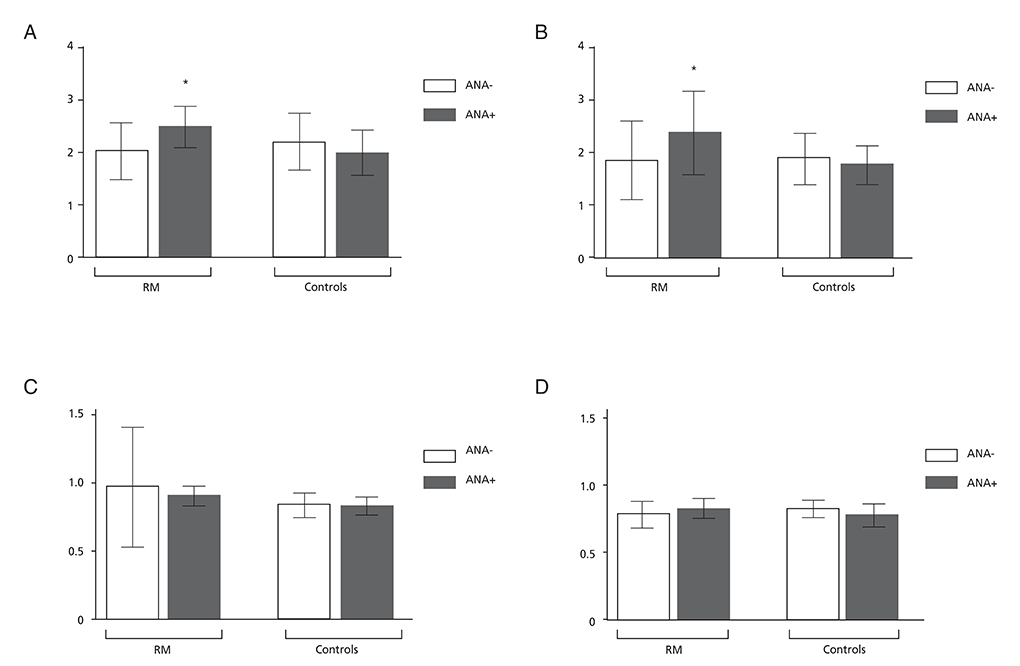Obstet Gynecol Sci.
2015 Nov;58(6):453-460. 10.5468/ogs.2015.58.6.453.
Uterine blood flow indices, antinuclear autoantibodies and unexplained recurrent miscarriage
- Affiliations
-
- 1Academic Department of Biomedicine and Prevention, Section of Gynecology and Obstetrics, Tor Vergata University, Rome, Italy. valentinabruno_86@hotmail.it
- 2Department of Experimental Medicine and Surgery, Tor Vergata University Hospital, Tor Vergata University, Rome, Italy.
- KMID: 2314060
- DOI: http://doi.org/10.5468/ogs.2015.58.6.453
Abstract
OBJECTIVE
To study the correlation between 2D and 3D uterine flow indexes and the presence or the absence of antinuclear antibodies (ANA) in women with unexplained recurrent miscarriage (uRM).
METHODS
Fifty-two subjects (26 uRM and 26 control women) underwent 2D Doppler measurement of pulsatility index and resistance index of the uterine arteries in both the follicular and midluteal phase of the cycle. Additionally, 3D ultrasonography determination of vascularisation index, flow index, and vascularisation flow index was carried out with the aid of the VOCAL technique. Serum assay for the presence of ANA was performed in all women.
RESULTS
Pulsatility index of ANA+ uRM women was higher than that of ANA- uRM women and control ANA+ and ANAwomen, both in the follicular and in the midluteal phase of the cycle. Vascularisation index in ANA- uRM women was significantly higher than that in ANA+ control women. Flow index in uRM ANA+ women was significantly lower than that of each of the other groups.
CONCLUSION
ANA might be involved in uRM by determining an impairment in uterine blood flow hemodynamic, particularly in uterine blood flow intensity and uterine artery impedance.
Keyword
MeSH Terms
Figure
Reference
-
1. Brezina PR, Kutteh WH. Classic and cutting-edge strategies for the management of early pregnancy loss. Obstet Gynecol Clin North Am. 2014; 41:1–18.2. VandenBerg MM, Vissenberg R, Goddijn M. Recurrent miscarriage clinics. Obstet Gynecol Clin North Am. 2014; 41:145–155.3. Saravelos SH, Regan L. Unexplained recurrent pregnancy loss. Obstet Gynecol Clin North Am. 2014; 41:157–166.4. Christiansen OB, Steffensen R, Nielsen HS, Varming K. Multifactorial etiology of recurrent miscarriage and its scientific and clinical implications. Gynecol Obstet Invest. 2008; 66:257–267.5. Li TC, Makris M, Tomsu M, Tuckerman E, Laird S. Recurrent miscarriage: aetiology, management and prognosis. Hum Reprod Update. 2002; 8:463–481.6. Jaslow CR, Carney JL, Kutteh WH. Diagnostic factors identified in 1020 women with two versus three or more recurrent pregnancy losses. Fertil Steril. 2010; 93:1234–1243.7. Mor G, Cardenas I, Abrahams V, Guller S. Inflammation and pregnancy: the role of the immune system at the implantation site. Ann N Y Acad Sci. 2011; 1221:80–87.8. Racicot K, Kwon JY, Aldo P, Silasi M, Mor G. Understanding the complexity of the immune system during pregnancy. Am J Reprod Immunol. 2014; 72:107–116.9. Kwak-Kim J, Park JC, Ahn HK, Kim JW, Gilman-Sachs A. Immunological modes of pregnancy loss. Am J Reprod Immunol. 2010; 63:611–623.10. Matthiesen L, Kalkunte S, Sharma S. Multiple pregnancy failures: an immunological paradigm. Am J Reprod Immunol. 2012; 67:334–340.11. Bansal AS. Joining the immunological dots in recurrent miscarriage. Am J Reprod Immunol. 2010; 64:307–315.12. Kwak-Kim J, Bao S, Lee SK, Kim JW, Gilman-Sachs A. Immunological modes of pregnancy loss: inflammation, immune effectors, and stress. Am J Reprod Immunol. 2014; 72:129–140.13. Carp HJ, Selmi C, Shoenfeld Y. The autoimmune bases of infertility and pregnancy loss. J Autoimmun. 2012; 38(2-3):J266–J274.14. Bansal AS, Bajardeen B, Shehata H, Thum MY. Recurrent miscarriage and autoimmunity. Expert Rev Clin Immunol. 2011; 7:37–44.15. Xu L, Chang V, Murphy A, Rock JA, Damewood M, Schlaff W, et al. Antinuclear antibodies in sera of patients with recurrent pregnancy wastage. Am J Obstet Gynecol. 1990; 163(5 Pt 1):1493–1497.16. Ticconi C, Rotondi F, Veglia M, Pietropolli A, Bernardini S, Ria F, et al. Antinuclear autoantibodies in women with recurrent pregnancy loss. Am J Reprod Immunol. 2010; 64:384–392.17. Molazadeh M, Karimzadeh H, Azizi MR. Prevalence and clinical significance of antinuclear antibodies in Iranian women with unexplained recurrent miscarriage. Iran J Reprod Med. 2014; 12:221–226.18. Ying Y, Zhong YP, Zhou CQ, Xu YW, Ding CH, Wang Q, et al. A further exploration of the impact of antinuclear antibodies on in vitro fertilization-embryo transfer outcome. Am J Reprod Immunol. 2013; 70:221–229.19. Habara T, Nakatsuka M, Konishi H, Asagiri K, Noguchi S, Kudo T. Elevated blood flow resistance in uterine arteries of women with unexplained recurrent pregnancy loss. Hum Reprod. 2002; 17:190–194.20. Ferreira AM, Pires CR, Moron AF, Araujo Junior E, Traina E, Mattar R. Doppler assessment of uterine blood flow in recurrent pregnancy loss. Int J Gynaecol Obstet. 2007; 98:115–119.21. Nakatsuka M, Habara T, Noguchi S, Konishi H, Kudo T. Impaired uterine arterial blood flow in pregnant women with recurrent pregnancy loss. J Ultrasound Med. 2003; 22:27–31.22. Masini S, Ticconi C, Gravina P, Tomassini M, Pietropolli A, Forte V, et al. Thrombin-activatable fibrinolysis inhibitor polymorphisms and recurrent pregnancy loss. Fertil Steril. 2009; 92:694–702.23. Ticconi C, Giuliani E, Veglia M, Pietropolli A, Piccione E, Di Simone N. Thyroid autoimmunity and recurrent miscarriage. Am J Reprod Immunol. 2011; 66:452–459.
- Full Text Links
- Actions
-
Cited
- CITED
-
- Close
- Share
- Similar articles
-
- Elevated natural killer cell levels and autoimmunity synergistically decrease uterine blood flow during early pregnancy
- Resistance of uterine radial artery blood flow is positively correlated with peripheral blood NK cell fraction in patients with unexplained recurrent spontaneous abortion
- Neonatal Lupus Erythematosus
- The Efficacy on the Immunotherapy with Paternal Lymphocytes in Unexplained Infertility
- Prevalence of Autoantibodies in Patients with Endometriosis



